Basic AI Chatbot Pricing: A simple chatbot that can answer questions about a product or service might cost around $10,000 to develop.
Read More
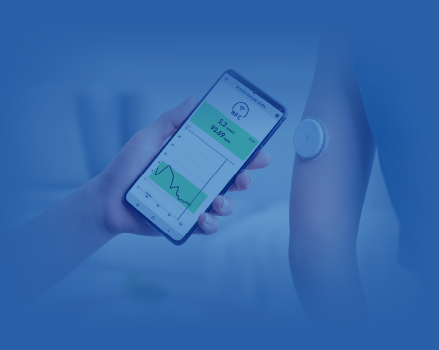
TL; DR

Cost to Build AI Body Measurement App: The development cost typically ranges from $50,000 to $300,000, depending on features, AI complexity, and compliance requirements.

What Drives the Cost Up: Key factors include 3D body scanning tech, AI/ML model sophistication, wearable device integrations, and ensuring HIPAA/GDPR compliance.

Monetization Matters: Profitable strategies include freemium models, subscriptions, in-app purchases, affiliate marketing, and B2B licensing for gyms or wellness brands.

How to Optimize the Budget: Save money by starting with an MVP, using tools like 3DLook API, opting for cross-platform development, and choosing a hybrid onshore-offshore team model.

Real-World Example: Biz4Group’s Glute AI app reduced time and cost by using the 3DLook API and focusing on a niche fitness segment, proving the value of smart strategy.

Top AI Body Measurement Apps: Noteworthy competitors include Glute AI, ZOZOFIT, Bodygee, Nettelo and more — each offering unique features from 3D scanning to posture tracking and B2B solutions.
There's a lot of buzz about AI these days. Some say it's revolutionizing
healthcare. Some say it's just a flashy buzzword dressed in code.
But let's be honest - what most decision-makers really want to
know is this:
What is the cost of AI Body Measurement App Development?
So let's clarify that.
If you're a CEO, CTO, or a founder of a healthtech startup thinking about building your own AI body measurement app - maybe something like Glute AI - then this blog is your budgeting bible.
Because here's the truth no one puts on their website:
Building an AI body measurement app isn't cheap.
But it doesn't have to wreck your burn rate either - if you know
where the money goes, and what's actually worth spending on.
In this post, we're going to unpack questions related to "what is the cost to build AI body measurement app":
· And what it really takes to bring one to life without turning into a money pit.
So yeah, no fluff. No jargon. Just a real look at how much and why - with numbers, logic, and a little bit of attitude.
Let's talk about what you're actually paying for.
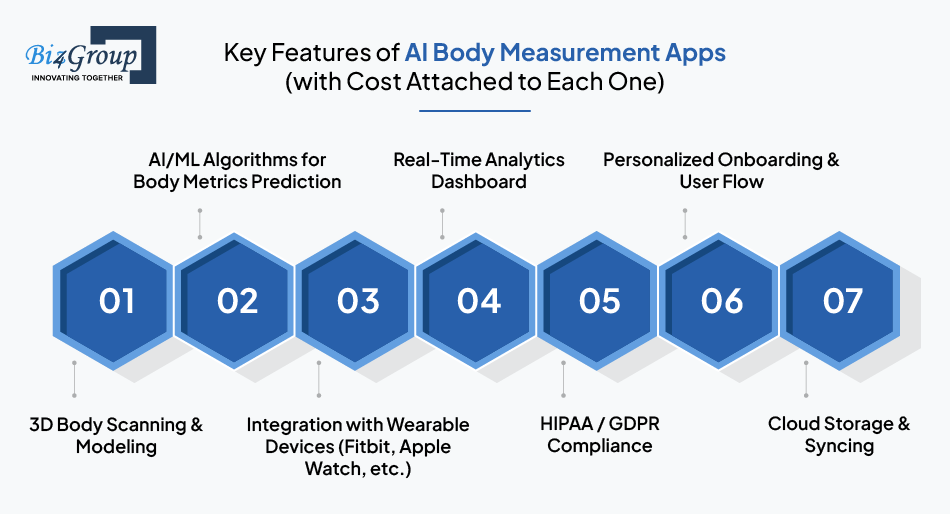
Here's the thing about AI body measurement apps - they sound simple when
you pitch them in a meeting.
"Just scan the body, take some measurements, show some insights, maybe
integrate it with a fitness tracker."
Yeah… no. That's like saying, "Just build Netflix but for dogs."
The devil - and the dollars - are in the details.
Let's break down the core features you actually need, and what they'll cost you in real-world terms.
This is your app's crown jewel. The feature that makes people go, "Whoa."
It takes basic inputs (usually images or video) and reconstructs a full
3D model of the user's body using computer vision and deep learning.
Cool? Absolutely. Cheap? Nope.
Estimated Cost: $15,000 - $25,000
Because building (or licensing) this kind of tech takes time, precision,
and a fair amount of GPU burn.
Fun Fact: The Glute AI project by Biz4Group pulled this off using the 3D Look API - a smart move that allowed them to skip the expensive 3D mapping build and go live faster, without compromising on visual accuracy or usability.
It's not enough to build a model. You've got to interpret it. That's where AI steps in - predicting things like body fat %, muscle mass, posture alignment, etc.
Estimated Cost: $20,000 - $35,000
Training custom models (especially if you want accuracy) requires datasets,
smart engineers, and time. Lots of it.
Why stop at visuals when you can combine real-time biometrics with physical
measurements?
Heart rate, step count, calories burned - your app becomes a full-blown
health ecosystem.
Estimated Cost: $8,000 - $12,000
Bonus: This opens up partnership opportunities with fitness brands.
Monetization alert!
Well! Speaking of fitness brands and so fitness apps, who knows that this could be a helpful read for you - How to create a fitness app- equipped with AI features.
Data is great. Real-time insights are better. This is where users can see their progress, trends, and comparisons.
Estimated Cost: $10,000 - $15,000
Yes, it's mostly front-end + API integration - but if done poorly, it'll
look like a glorified spreadsheet. Invest in good UX here.
How about implementing
AI for UX
design on that note?
If you're dealing with body data in healthcare - congrats, you're now
legally responsible for protecting it.
Encrypted storage, user consent flows, audit logs… you don't get to ignore
this one.
Estimated Cost: $5,000 - $10,000
Saves you a lawsuit. Worth every cent.
First impressions matter. Nobody wants to spend 12 minutes figuring out how
to scan their body.
Guided onboarding with smart defaults makes or breaks early adoption.
Estimated Cost: $5,000 - $8,000
Get a UX designer who understands both human behavior and tech. Your churn
rate will thank you.
On that note, here's a bonus read for you to delve deeper into UI/UX design cost .
Where's all that 3D data going? Not your user's local phone storage, that's
for sure.
You'll need cloud infra to store, retrieve, and sync data - securely.
Estimated Cost: $6,000 - $10,000
Hint: Avoid overengineering with AWS if you're not serving a million users.
Start lean.
You don't need all of these features on Day 1. But the ones you do
choose?
You better know what you're paying for - because this is where most budgets
get torched.
Now that we've put some price tags on features, let's move on to the next big thing: what actually drives these costs up or down - because there are ways to do this smartly (and ways to burn your cash in record time).
Launch AI-powered body measurement apps faster with experts who’ve built them before.
Let’s Connect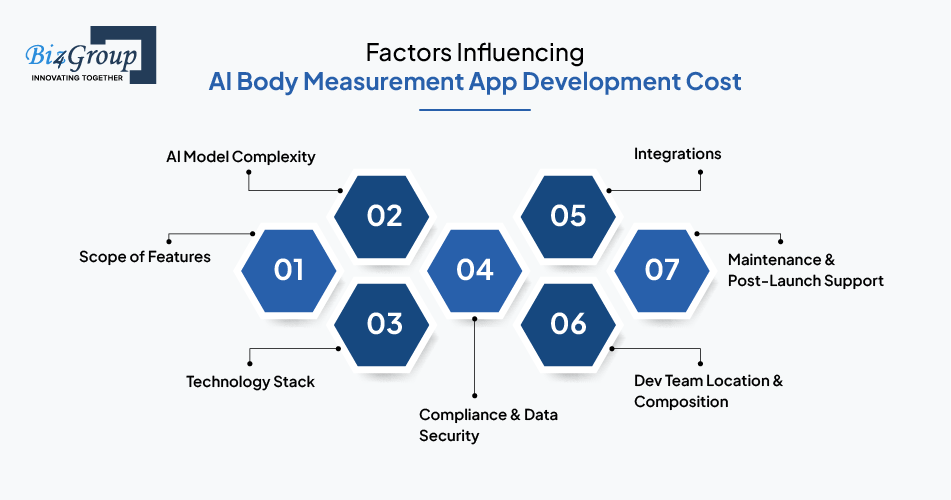
Let's get one thing out of the way: no two AI apps cost the same.
You can't just Google "How much to build a body measurement app?" and
expect an answer that works for your specific use case. You need to
understand what actually drives the price up (or down).
Here's the list of cost magnets - the things that'll either eat your budget alive or help you keep it lean (if you're smart about them).
Let's say you want a basic MVP - a couple of measurements, an onboarding
flow, and a dashboard.
Cool. That's doable.
But if you start asking for AI-driven posture analysis, real-time progress heatmaps, personalized recommendations, wearable syncing, AR overlays, and a built-in gym playlist?
Yeah, that's not an MVP anymore. That's a full-fledged SaaS platform.
More features = more dev time = more dollars.
Speaking of MVP, it's worth exploring the cost to build an MVP for AI body measurement app .
Are you building native iOS and Android separately? Or going cross-platform with Flutter or React Native?
Are you using 3DLook API for scanning, or are you building your own 3D engine from scratch?
Are you using AWS with GPU instances? Or going lean with Firebase and third-party AI hosting?
Each tech choice comes with a price tag - not just in licensing, but in developer hours and long-term maintainability.
You could use off-the-shelf models. Or you could build custom deep learning models trained on thousands of human body types.
Custom = more accurate + more powerful
Also Custom = more data, more devs, more $$$
And let's not forget model retraining, which isn't a one-time job. Your app needs to get smarter over time - which means ongoing work (and ongoing spend).
Healthcare + user body data = regulatory minefield.
You're dealing with sensitive information, and that means you'll need:
Compliance isn't optional. It's part of the cost of doing business in healthtech.
Want your app to sync with Apple Health? Fitbit? Telemedicine portals? EHR systems? Payment gateways?
Each integration sounds like a tiny task.
Spoiler alert: It never is.
Especially when you're dealing with real-time data,
data formatting hell, and
third-party API limits
.
This is a big one. A senior AI engineer in San Francisco can charge you
$200/hour.
The same quality of work from a vetted offshore team? Closer to $50/hour -
sometimes less.
It's not just about cost - it's about structure. You'll need:
Which brings us to…
Your app doesn't stop costing money once it hits the App Store.
You'll need ongoing:
Plan for 15-20% of your initial build cost as annual maintenance.
Ignore that, and your app will die a slow, buggy death.
Bottom line:
AI app development cost
isn't random.
Every decision - from the tech you use to the team you hire - affects your
bottom line.
From 3D body scans to real-time health dashboards — build apps that flex serious AI muscle.
Book a Free Consultation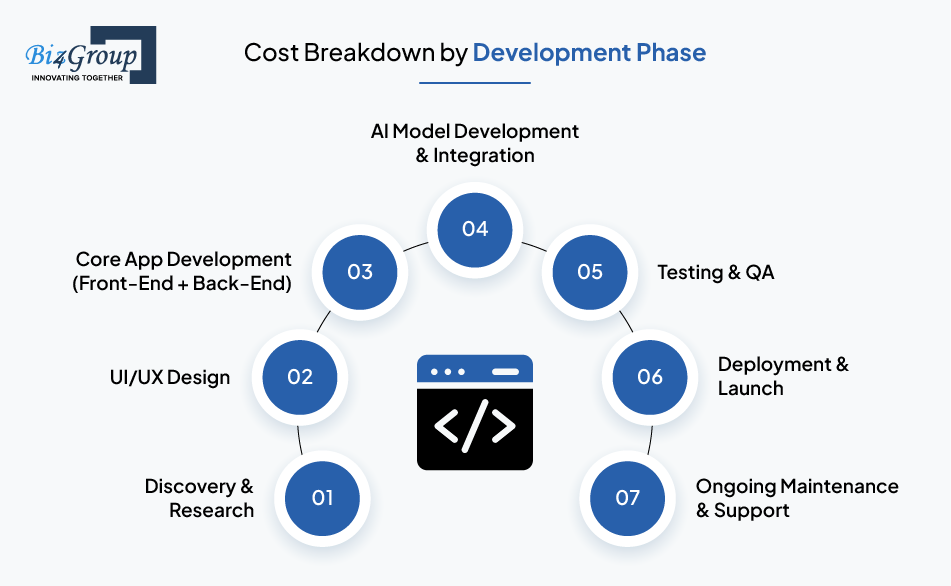
Okay, so you've got your dream app features listed out. You know what
drives the cost.
Now let's talk real numbers - because your CFO isn't going to approve "it
depends" as a budget line.
Here's where your money's going, phase by phase:
You might be tempted to skip this part.
Don't.
This is where you figure out:
You'll save thousands later by not building features no one wants.
Estimated Cost: $5,000 - $8,000
Think wireframes, user journeys, prototypes, design systems - all the good stuff that makes an app usable and not look like it was made in 2007.
Good UX = higher engagement
Bad UX = churn city
Estimated Cost: $7,000 - $10,000
Here's where most of your budget goes. You're building:
Estimated Cost: $25,000 - $40,000
More if you go native. Less if you go hybrid. Way more if you keep changing
your mind mid- sprint. Just saying.
Want body measurements, predictions, or smart insights?
You're going to need:
Estimated Cost: $20,000 - $35,000
Or you could plug in something like 3DLook API (like Glute
AI did) and cut time to market in half. Totally depends on your product
vision.
Everything works great... until users start using it.
This stage involves:
Estimated Cost: $7,000 - $12,000
Not just pushing the app live - we're talking:
Estimated Cost: $5,000 - $8,000
After the launch party, someone's got to keep the lights on.
This includes:
Estimated Cost: $2,000 - $5,000/month
Plan for this. Don't ghost your own app.
MVP Build: $60,000 - $100,000
Full-Feature Product: $300,000 or so.
Your mileage may vary depending on team structure, tools, and the number of
cooks in the kitchen.
Discover the real Glute Workout Planner AI App Development Cost — and build smarter, faster, and stronger.
Let’s Connect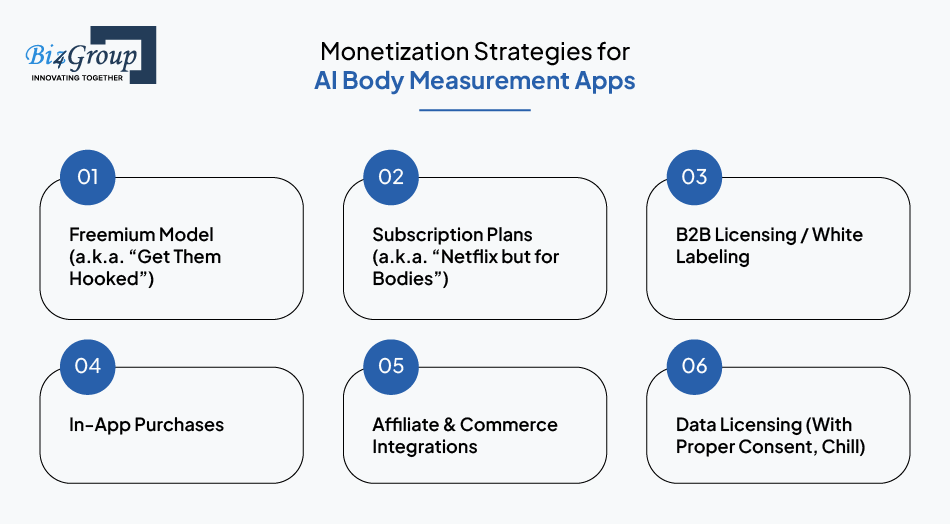
Let's be blunt: building this app is an investment.
And unless you're doing it out of sheer love for machine learning and body
analytics (in which case, respect), you probably want a return on that
investment.
So let's talk about how this app of yours can actually make money - not just look pretty on Product Hunt.
Give users a taste - body scan, basic metrics, maybe one visual comparison.
Then lock the good stuff: personalized insights, progress tracking,
downloadable reports, priority support.
Why it works:
Low entry barrier + high upgrade incentive = win.
People love free stuff. People also love knowing exactly how their
body is changing week to week.
Bonus Tip: This is exactly the kind of upsell a product like Glute AI can lean into - basic scan is free, advanced glute tracking and pro-level insights come with a monthly tag.
Go monthly. Go yearly. Just go recurring.
You can tier your plans like this:
Why it works:
Predictable revenue. Great for SaaS-style business models. And once users
start seeing results, they'll keep paying to keep the streak alive.
Here's where things get spicy.
Sell your tech (or license your app) to:
Why it works:
They get to slap their logo on a high-tech solution without building it.
You get scale and recurring B2B revenue.
Pro move: Offer a branded version of your app with analytics dashboards for client management.
This one's simple.
Sell:
Why it works:
The more value users get from your app, the more likely they are to pay for
micro-upgrades.
If your app knows someone's body shape, measurements, and goals - you've
got gold.
Partner with:
Sell gear. Recommend products. Track clicks. Earn commissions.
Why it works:
It's passive income, and it fits naturally into the user experience.
If you're capturing anonymized body metric data over time, there are research orgs and fitness brands out there who'd love to see it.
BUT - and this is a big but - this only works if:
Use responsibly, and it can be a solid secondary stream.
Bottom line:
You don't need all of these revenue models.
Pick 1-2 based on your audience, and do them really well.
Build trust. Deliver value. Then monetize like a boss.
Uncover the true cost of developing Glute Analysis AI app with expert-backed strategy and scalable AI.
Let’s ConnectOkay, so you're thinking of building the next big AI body measurement app.
But you're not the only genius in the room. Other companies have already dipped their toes in this pool - some with elegance, some with… less.
So let's talk about the current players, what they offer, and more importantly - how you can position your app to stand out.
The name's quirky, the tech is solid. ZOZOFIT lets users scan their bodies using their phones (via their special ZOZOSUIT or without), then visualizes their 3D model and body fat percentages.
What they nailed:
Where there's space:
Focused more on gyms, wellness studios, and personal trainers. Bodygee creates visual 3D body models and tracks changes over time - mostly in a B2B setup.
What they nailed:
Where there's space:
Nettelo uses AI and smartphone cameras to provide health, fitness, and posture-related body measurements.
What they nailed:
Where there's space:
Speaking of fitness apps like Nettelo, here is an interesting read on cost to develop AI fitness app .
A hyper-focused body measurement app - but with a twist. It specializes in glute tracking. Built using the 3DLook API, it's designed for fitness-conscious users who care about performance, aesthetics, or targeted progress tracking.
What it nailed:
Where it stands out:
Here's the playbook:
The good news?
There's still plenty of white space in this market -
especially if you're looking at women's health, rehabilitation, sports
science, or remote patient care.
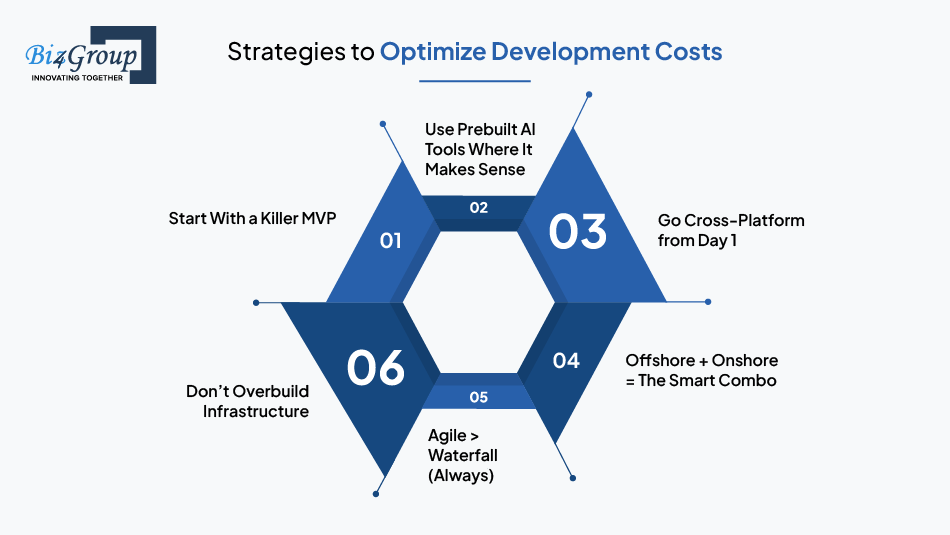
Let's be real for a second:
You can spend $300K building an AI body measurement app.
But should you?
Unless you've got VC money raining from the sky (congrats if you do), you're probably trying to balance ambition with reality. And that's a good thing - because blowing your budget too early is how promising startups flatline before launch.
So, here's how to build smarter, leaner, and still end up with an app that actually works (and sells).
Don't build a "super app" out of the gate. That's how you end up spending $100K on features no one even uses.
Instead:
MVP > Frankenstein Feature List
You don't always need to reinvent the AI wheel.
Want 3D body scans? Use something like 3DLook API (like
Glute AI did).
Want basic body part segmentation? TensorFlow + MediaPipe will do the trick
for early builds.
Build your own AI only when:
Everything else? Plug and play.
Unless you need pixel-perfect performance on native iOS or
Android, go with React Native or Flutter.
One codebase = faster development = fewer developers = lower cost.
It's 2025. Cross-platform is no longer the compromise it used to be.
You don't need a 100% U.S.-based team to get quality work.
You also don't want 100% offshore if you're dealing with HIPAA, complex
infrastructure, or client-facing leadership.
The sweet spot?
Hybrid teams. Like what Biz4Group, an
AI development company in USA
does - U.S.-based strategy and PM, with offshore development firepower.
You save on cost and get top-tier delivery.
Don't wait 6 months to see your first build.
Ship fast. Get feedback. Fix what's broken. Add what's missing.
Agile development lets you:
Also? It keeps your investors happy. Just saying.
Yes, your app needs to scale.
But no, you don't need Kubernetes + microservices + custom logging infra on
Day 1.
Start with:
You can refactor once the user base justifies it. Not before.
Bottom line:
You don't need less ambition. You just need
more strategy
.
Let's be honest: you can spend months trying to vet agencies, hire freelancers, piece together a dev team, train them on AI, coach them on HIPAA, and hope they don't ghost you mid-sprint.
Or…
You could just work with a team that's done it before. Successfully. In this exact niche.
Enter: Biz4Group.
Here's why we're not just another dev shop with a slick website.
Glute AI wasn't some experiment - it was a real app, with
real users, and a real go-to-market plan.
The team didn't waste time building fancy tech for the sake of it. They
used 3DLook API, added deep personalization, and shipped a
polished product fast.
Result?
A focused body measurement app that tracks glute development like a pro -
with stunning UX and AI-backed insights.
HIPAA compliance?
Data privacy?
Regulatory messes that could land you in court?
Yeah, they know the drill. Biz4Group has built multiple healthcare and wellness apps, so we won't fumble the basics (which, by the way, is where most dev teams do).
Biz4Group isn't your typical "offshore = cheap" setup.
They bring:
You don't want a dev partner who says "yes" to everything and delivers
nothing.
You want someone who'll challenge your idea, shape it, streamline it, and
then build it like we've got skin in the game.
That's Biz4Group. We're not just building apps.
We're building your business.
Validate your idea with a lean MVP before diving deep into full-scale AI app development.
Schedule a CallBy now, you've seen the full picture:
· Individual feature's price falling under AI app development cost for glute analysis
So what's the final takeaway?
Building an AI body measurement app will cost you - but it doesn't have
to bankrupt your startup.
You just need clarity, the right priorities, and a team that knows what
they're doing.
If you're thinking of launching your own product in this space - healthcare, fitness, rehab, virtual diagnostics - don't go in blind.
Talk to us.
We've done it before. We can do it again - this time, for you.
The development cost for an AI Body Measurement App can vary significantly based on factors such as feature complexity, technology stack, and development team location. On average, costs may range from $50,000 to $300,000 . For instance, developing an app similar to Fitbod, which includes advanced AI features, can fall within this range.
Essential features for an AI Body Measurement App include:
Several factors can impact the development cost, including:
Monetization strategies include:
Yes, integrating pre-built solutions like the 3DLook API can expedite development. This API offers accurate body measurement and 3D modeling capabilities, allowing developers to incorporate these features without building them from scratch.
By leveraging such existing technologies, you can reduce development time and costs while still delivering a high-quality product.
IN YOUR BUSINESS FOR FREE
Our website require some cookies to function properly. Read our privacy policy to know more.